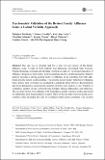Files in this item
Psychometric validation of the revised family affluence scale : a latent variable approach
Item metadata
| dc.contributor.author | Torsheim, Torbjørn | |
| dc.contributor.author | Cavallo, Franco | |
| dc.contributor.author | Levin, Kate Ann | |
| dc.contributor.author | Schnohr, Christina | |
| dc.contributor.author | Mazur, Joanna | |
| dc.contributor.author | Niclasen, Birgit | |
| dc.contributor.author | Currie, Candace Evelyn | |
| dc.contributor.author | FAS Development Study Group | |
| dc.date.accessioned | 2016-02-24T11:10:04Z | |
| dc.date.available | 2016-02-24T11:10:04Z | |
| dc.date.issued | 2016-09 | |
| dc.identifier | 240165339 | |
| dc.identifier | 9a831b8d-6104-49f9-a068-711d00fa057b | |
| dc.identifier | 84979211143 | |
| dc.identifier | 000380155800012 | |
| dc.identifier.citation | Torsheim , T , Cavallo , F , Levin , K A , Schnohr , C , Mazur , J , Niclasen , B , Currie , C E & FAS Development Study Group 2016 , ' Psychometric validation of the revised family affluence scale : a latent variable approach ' , Child Indicators Research , vol. 9 , no. 3 , pp. 771-784 . https://doi.org/10.1007/s12187-015-9339-x | en |
| dc.identifier.uri | https://hdl.handle.net/10023/8294 | |
| dc.description.abstract | The aim was to develop and test a brief revised version of the family affluence scale. A total of 7120 students from Denmark, Greenland, Italy, Norway, Poland, Romania, Scotland and Slovakia reported on a list of 16 potential indicators of affluence. Responses were subject to item screening and test of dimensionality. Bifactor analysis revealed a strong general factor of affluence in all countries, but with additional specific factors in all countries. The specific factors mainly reflected overlapping item content. Item screening was conducted to eliminate items with low discrimination and local dependence, reducing the number of items from sixteen to six: Number of computers, number of cars, own bedroom, holidays abroad, dishwasher, and bathroom. The six-item version was estimated with Samejima’s graded response model, and tested for differential item functioning by country. Three of the six items were invariant across countries, thus anchoring the scale to a common metric across countries. The six-item scale correlated with parental reported income groups in six out of eight countries. Findings support a revision to six items in the family affluence scale. | |
| dc.format.extent | 14 | |
| dc.format.extent | 380297 | |
| dc.language.iso | eng | |
| dc.relation.ispartof | Child Indicators Research | en |
| dc.subject | SES | en |
| dc.subject | FASIII | en |
| dc.subject | Measurement | en |
| dc.subject | Adolescence | en |
| dc.subject | HBSC | en |
| dc.subject | H Social Sciences | en |
| dc.subject | R Medicine | en |
| dc.subject | NDAS | en |
| dc.subject.lcc | H | en |
| dc.subject.lcc | R | en |
| dc.title | Psychometric validation of the revised family affluence scale : a latent variable approach | en |
| dc.type | Journal article | en |
| dc.contributor.institution | University of St Andrews. School of Medicine | en |
| dc.contributor.institution | University of St Andrews. WHO Collaborating Centre for International Child & Adolescent Health Policy | en |
| dc.contributor.institution | University of St Andrews. Child and Adolescent Health Research Unit | en |
| dc.identifier.doi | https://doi.org/10.1007/s12187-015-9339-x | |
| dc.description.status | Peer reviewed | en |
| dc.identifier.url | http://link.springer.com/article/10.1007%2Fs12187-015-9339-x | en |
This item appears in the following Collection(s)
Items in the St Andrews Research Repository are protected by copyright, with all rights reserved, unless otherwise indicated.

